1.0 A Language Hollowed Out
Our work as "Digital Archaeologists" is predicated on a single, foundational belief: the "hand-built web" of the 1990s and early 2000s was not a primitive beta test. It was a "World Wild West" of human creativity, a civilization defined by a radical commitment to self-declaration, intentional connection, and digital sovereignty.
And like any great civilization, it had its own language.
It was a language born of necessity and joy, of technical constraints and human ingenuity. It was a language of "keypals" and "webrings," of "uh-oh!" notifications and "13375p34k." This was a language forged by human hands, each word an artifact imbued with story, context, and a sense of belonging.
Today, that language is endangered.
We are living in an age of the "hollowed-out word." Language has become a disposable commodity, algorithmically optimized for "engagement" and "virality." It has been flattened by the "soulless jargon" of corporate-speak and the context-free churn of the feed. We are awash in "content" but starved for meaning. We have traded a language of "connection" for a language of "metrics."
This is not a complaint; it is a diagnosis. And it is the "why" behind one of our foundry's most important "Digital Monuments": The Lexicon of Digital Culture.
This Lexicon is not a dictionary. A dictionary is a tool for utility, a flat, alphabetical list of definitions. This Lexicon is a museum. It is an act of "Digital Archaeology," a "quiet, well-kept library" for the preservation of the "Digital Artifacts" that form our collective memory.
It is the ultimate expression of our Archive, a "living" collection where each entry is a "Landmark," not just an "address." This essay is its curatorial statement.
2.0 The Discipline: The Archive as Museum
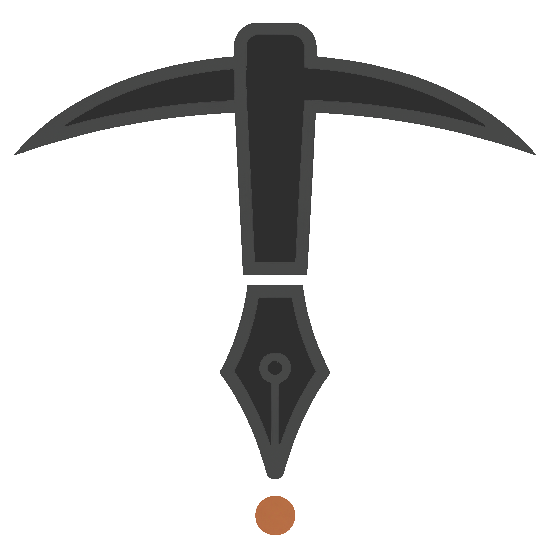
Our foundry's discipline is Archive & Anvil. The Lexicon is perhaps the purest expression of this dual practice.
The Archive is the act of "excavating, cataloguing, and preserving" these linguistic artifacts. It is the scholarly "why" and "how" of our curatorial process.
The Anvil is the craft of forging that raw research into a public-facing "Digital Monument"—the browsable, beautiful, and "Grounded & Human" museum that we host for the community as a "gift of content."
To curate this Lexicon, we do not use algorithms. We use our three, human-led "Digital Archaeologist's Tools." This is our "proof-of-work," a transparent look at our curatorial methodology.
1. The Etymological Dig: Finding the "First Shard"
For every word in our Lexicon, we first conduct the Etymological Dig. We ask: What is this word's verifiable origin? This is our "Narrative Provenance." We trace the "linguistic DNA" of an artifact to its "first shard."
For a word like "blog," we trace it back to Jorn Barger's "weblog" in 1997, and then to Peter Merholz, who jokingly split it into "we blog" in 1999. This isn't just trivia; it's the story of a community creating its own tools.
For a word like "SPAM" (the unwanted message, not the meat), we dig back to the 1993 Usenet incident—a "mass automated posting" that one user compared to the infamous Monty Python sketch.
This "bedrock" is non-negotiable. It grounds our "Story" in verifiable truth, fulfilling our cardinal rule: No Fabrication. Ever.
2. The Cultural Survey: Mapping the "Narrative Gravity"
Once we have the "bedrock," we conduct the Cultural Survey. We map the "narrative gravity" of the word. We ask: What stories, myths, and human feelings orbit this artifact?
This is where we unearth the soul. A word like "keypal," for instance, is not just a "digital pen pal." The Survey reveals its "gravity"—it's an artifact of a high-friction, "intentional" era. It represents the "Pillar of Connection" in its purest form, a one-to-one human bond forged outside an algorithmic intermediary.
This is also where we categorize our "Dark Artifacts"—words that "shine a light on a necessary shadow." A word like "enshittification" (coined by Cory Doctorow) or our own unfriending.im are vital. They are the language we created to describe the "hollowing out" of the web itself. To preserve them is to preserve the critique of our era, a vital function of any honest archive.
3. The Intuitive Resonance Test: The "Human Filter"
Finally, we apply the Intuitive Resonance Test. This is our "human filter," the "expert intuition" of the "Digital Archaeologist."
We ask: Does this word have a soul? Does it pass the "Aha!" test of "processing fluency"?
This is how we identify "tribal" artifacts like 13375p34k.com. An algorithm sees "gibberish." Our "lived-in" history of the web allows us to see a "priceless symbol of authenticity" for a "tribe of early internet pioneers."
This is also how we unearth words of "poetic potential"—words like "vellichor" (the strange wistfulness of used bookstores) or "apricity" (the warmth of the sun in winter). These are not "web" words, but they are "Grounded & Human" words that deserve to be part of the web's future. The Resonance Test identifies them as "full casks," ready for a visionary founder to give them a new digital life.
3.0 The Galleries: A Tour of the Monument
This three-tool methodology has allowed us to organize our Lexicon not as a flat list, but as a museum with distinct galleries, each dedicated to a different facet of our digital lives. Based on the current structure of our digital museum, a visit is a journey through these dedicated wings:
Gallery 1: The Hand-Built Web
Curator's Note: This gallery preserves the language of a web built by hands, not by algorithms. These artifacts are a reminder that the most enduring digital spaces are those forged from human creativity and a sovereign desire to declare, 'I am here.'
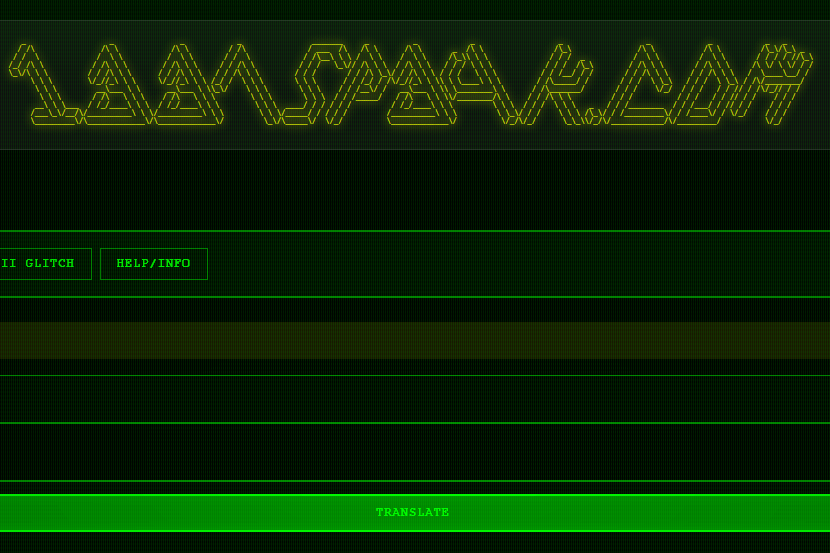
Artifact: 13375p34k.com ("Leet Speak")
- The Find: The "Declaration of Independence" for the "hacker ethos builder."
- The Story: "Leet" was a "glowing-green-text" language of ingenuity, a way to bypass text-filters and signal one's "insider" status. It is a "primal" artifact of "Digital Sovereignty"—a language of the machine, but against the machine. It embodies the playful, anti-authoritarian spirit that defined the early internet underground, a coded dialect that inherently filtered out the uninitiated and celebrated technical creativity.
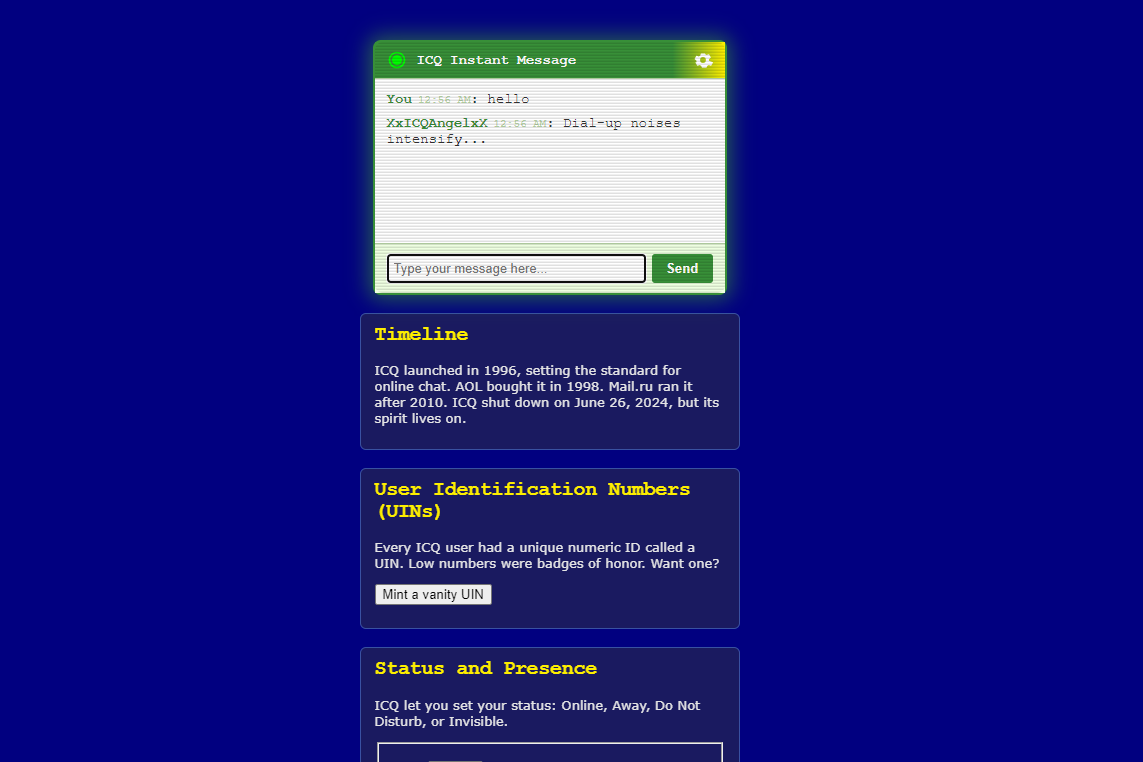
Artifact: uhoh.im (The "ICQ Sound")
- The Find: Not a word, but a *sound* that became a word, representing the "primal signal" of connection.
- The Story: For millions in the late '90s, this two-note "uh-oh!" was the "digital doorbell" announcing the arrival of a "keypal." It is an artifact of pure, unadulterated joy—a sound that promised connection, not distraction. In an age where our devices buzz with an endless stream of impersonal, algorithmic pings designed to manage our attention, the memory of "uh-oh!" serves as a powerful reminder of what we've lost: a notification system built for human-scale delight, not infinite engagement.
Gallery 2: Social Ritual
Curator's Note: Language is social action. This gallery documents the verbs we invented to navigate our increasingly mediated lives, often revealing the tensions between platform design and human needs.
Artifact: unfriending.im
- The Find: A "dark artifact" representing the "tiny click carrying the emotional weight of a real-world goodbye."
- The Story: This artifact tells a story of "Digital Separation." The platforms gave us frictionless tools to *add* connections, relentlessly optimizing for growth. But it was we, the users, who forged the painful but necessary verb for subtracting, asserting our human need for boundaries and closure in spaces designed to eliminate them. It's a monument to agency in the face of algorithmic social engineering.
Artifact: doomscrolling.im
- The Find: Coined in 2018, calcified in the 2020s. The act of "compulsively scrolling through bad news."
- The Story: This artifact is a visceral critique of the "attention economy" and the design of the infinite feed. The platforms provide the endless stream; "doomscrolling" is the human-generated term for the feeling of being helplessly caught in its current, consuming negativity long past the point of being informed. We preserve it as a stark warning about the psychological cost of engagement-at-all-costs.
Gallery 3: Architecture of Trust
Curator's Note: Trust isn't built on promises; it's built on proof. This gallery explores the language of digital identity, security, and ownership—the essential framework for a web worthy of our confidence.
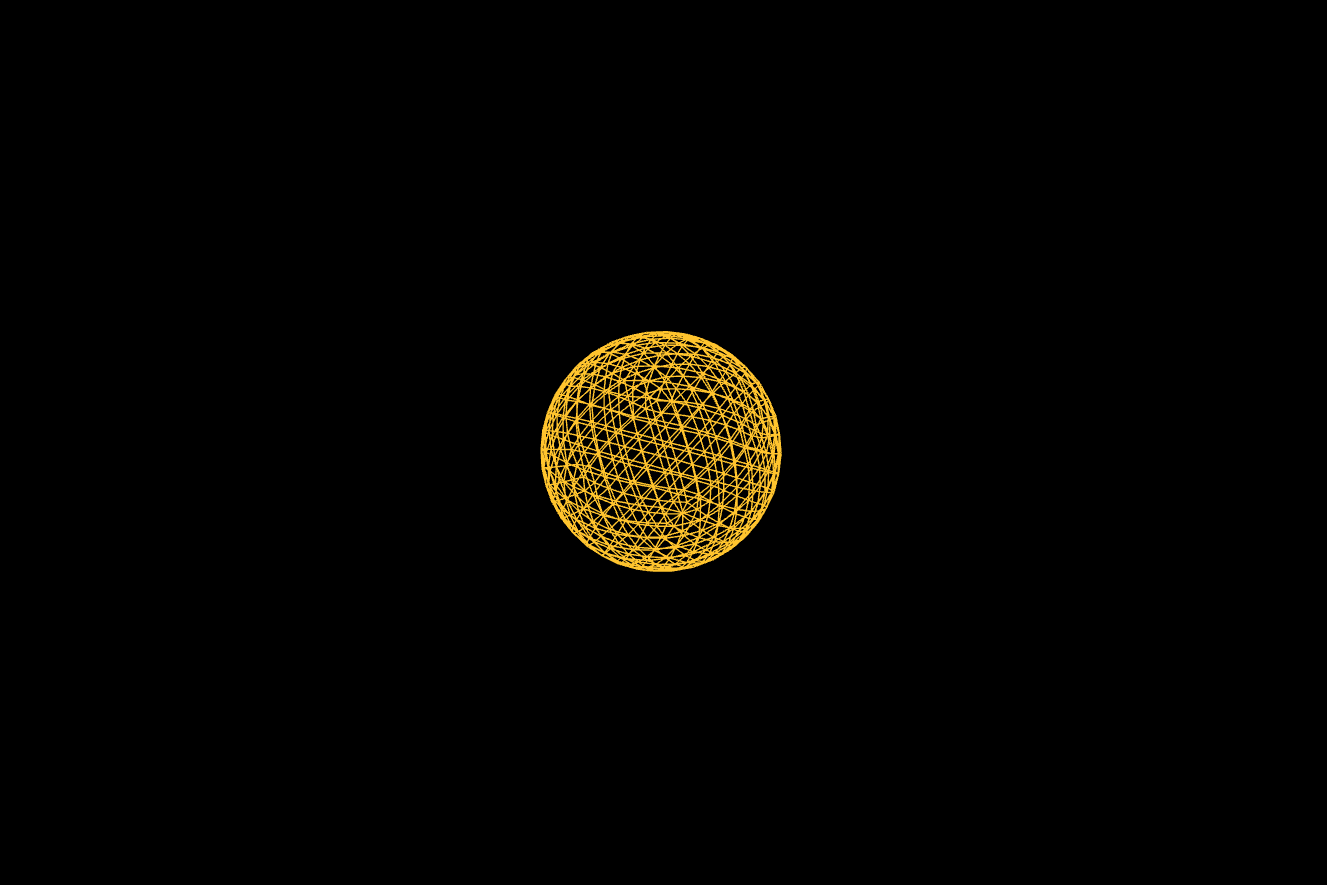
Artifact: sovereignty.im
- The Find: A direct representation of our "Pillar 3: Ground (Digital Real Estate)."
- The Story: This name embodies the fundamental principle of self-ownership and control in the digital realm, a concept eroded by decades of platform centralization. It's a declaration against digital landlords and walled gardens, a cornerstone for building the next generation of platforms where users, creators, and communities—not corporations—hold the power and own their ground.
Artifact: credential.im
- The Find: A name signifying proof, qualification, and verified identity.
- The Story: In an era demanding verifiable claims amidst a rising tide of synthetic media, this artifact represents the essential building block of digital trust. It speaks to authenticity, expertise, and the fundamental right to assert one's identity securely and reliably, forming the bedrock of meaningful online interactions.
Gallery 4: The Ghost in the Machine
Curator's Note: As machines become our collaborators and interlocutors, we forge new language to understand this strange and powerful relationship. This gallery captures the vocabulary emerging from the uncanny valley.
Artifact: aifart.art
- The Find: A provocative, irreverent artifact born from the unexpected, often absurd outputs of generative AI.
- The Story: This name captures the inherent unpredictability and occasional delightful absurdity of collaborating with non-human intelligence. It's a "primal signal" carrying the playful, experimental "weird web" ethos into the age of AI, serving as a humorous but pointed commentary on the often-unintended, unpolished, yet strangely compelling consequences of complex algorithms. It reminds us that creativity isn't always clean.
Artifact: circanova.im
- The Find: A name suggesting new cycles, generative systems, and emergent patterns.
- The Story: This artifact speaks directly to the immense creative potential unlocked by artificial intelligence. It evokes ideas of continuous creation, algorithmic art generation, and the cyclical, iterative nature of innovation as humans and machines learn to build together in entirely new ways. It's a name for the dawn of a new creative era.
Gallery 5: The Atelier
Curator's Note: Some names arrive brimming with story, carrying echoes from culture, art, or philosophy. This gallery showcases these "full casks," ready to be poured into new digital vessels.
Artifact: bootylicious.im
- The Find: A name arriving with immense "cultural gravity" from music and pop culture, coined by Destiny's Child.
- The Story: This artifact is a pure "Storyteller" name, a "gravity well" radiating joy, confidence, and unapologetic body positivity. It doesn't need a story painstakingly built around it; it is the story, instantly recognizable and resonant, ready to be reclaimed and reforged for a new generation or context celebrating self-love and empowerment.
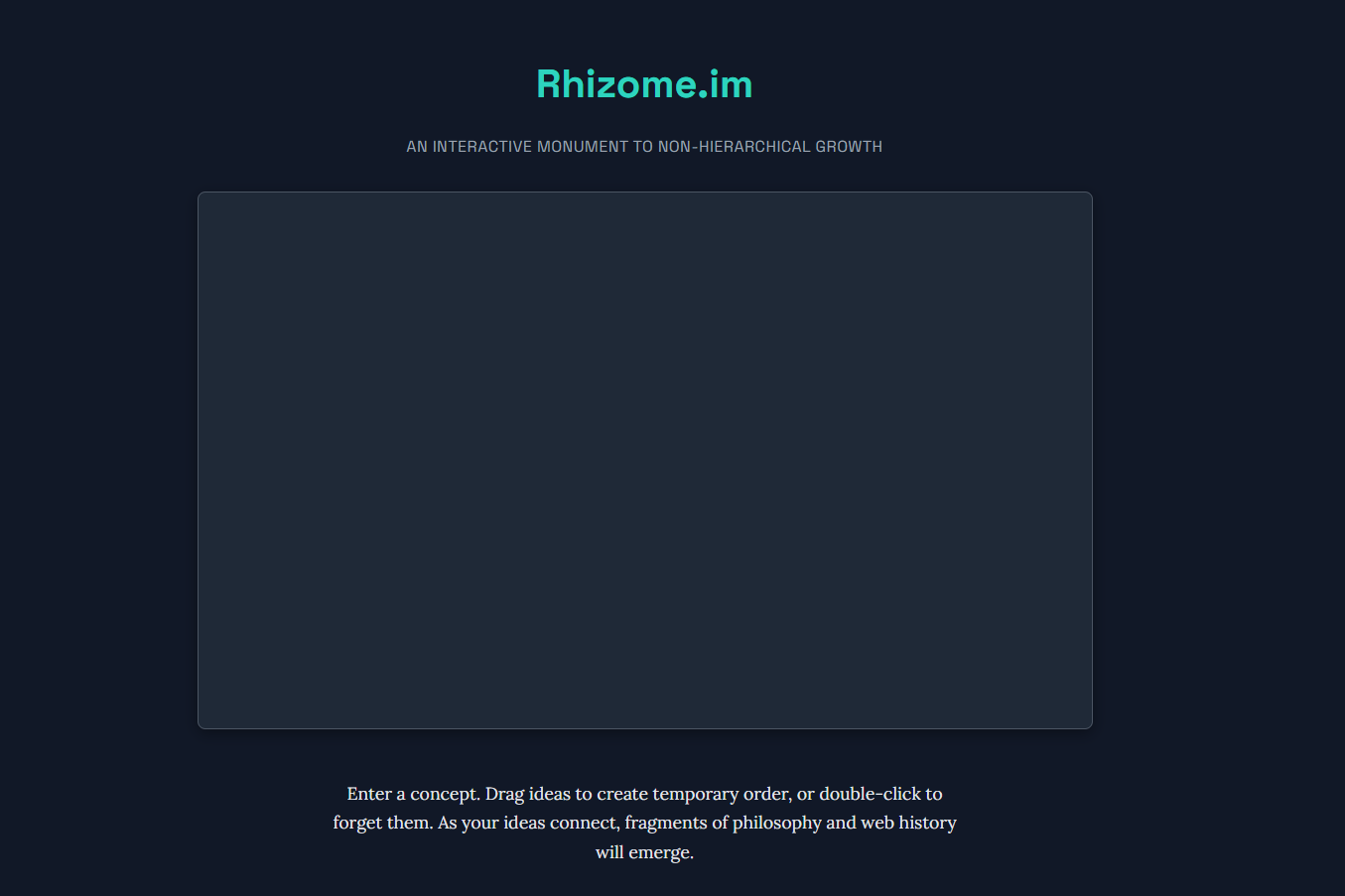
Artifact: rhizome.im
- The Find: A profound concept borrowed from the philosophy of Deleuze and Guattari, describing interconnected, non-hierarchical networks.
- The Story: This name speaks powerfully to decentralization, interconnectedness, and organic, emergent growth—principles deeply aligned with the original spirit of the "hand-built web" and the potential future of community online. It's an intellectually rich name for networked thought, collective intelligence, decentralized systems, or any project that rejects rigid hierarchy in favor of fluid connection.
Gallery 6: Cabinet of Curiosities
Curator's Note: The Digital Archaeologist sometimes unearths artifacts that defy easy categorization. This gallery holds these unique finds, each whispering an enigmatic invitation to explore.
Artifact: beniprint.com
- The Find: An interactive digital atelier exploring ephemeral art, inspired by the Japanese beni (safflower) dye.
- The Story: This artifact, forged on our Anvil, is a generative art monument. It explores themes of memory, touch, and impermanence ("Red as memory, print as breath"). User interaction (touch, motion) creates fleeting, ink-like visuals reminiscent of traditional beni dye, offering a meditative experience that contrasts with the web's usual demand for permanent content and constant engagement. It's a landmark to the beauty of the transient.
Artifact: sajce.com
- The Find: An interactive "Linguistic Forge" where sound, light, and language converge based on user presence.
- The Story: Another monument forged on our Anvil, Sajce (a name suggesting "essence," "self," or "is-ness") turns the user into a collaborator. Heat and motion detected by the device generate evolving ambient soundscapes. As the "heat" intensifies, abstract visual elements coalesce, and fragments of emergent language appear and dissolve. It's an experimental exploration of how meaning arises from interaction and energy, a digital space where language itself is unearthed through presence.
Gallery 7: Foundry Graduates
Curator's Note: Craftsmanship endures across mediums. This gallery features artifacts tied to specific industries or artistic practices, often reflecting the enduring value of analog traditions in a digital age.
Artifact: waxlore.com
- The Find: A name deeply connected to the culture, history, and craft of vinyl records.
- The Story: This artifact carries immense "inherent narrative weight" for storytelling around analog music, the rituals of collecting, and the tangible preservation of sound. It speaks directly to authenticity, connoisseurship, and the deeply human practice of curating and sharing physical media in an increasingly ephemeral digital world. It's the perfect landmark for a record label, a high-end audio gear brand, or a community dedicated to the love of vinyl.
Artifact: turntable.im
- The Find: A direct, iconic symbol of analog audio culture and the art of DJing.
- The Story: More than just a piece of equipment, the turntable represents a deliberate, high-fidelity, and often communal approach to experiencing music. This name is an instant landmark for audiophiles, DJs, record collectors, and anyone celebrating the enduring power, warmth, and ritualistic pleasure of vinyl in the digital age.
Gallery 8: The Lexicon Wing
Curator's Note: Language itself is a technology. This gallery is dedicated to the words *we* are forging—neologisms born from our own archaeological digs into the future of networks, AI, and consciousness.
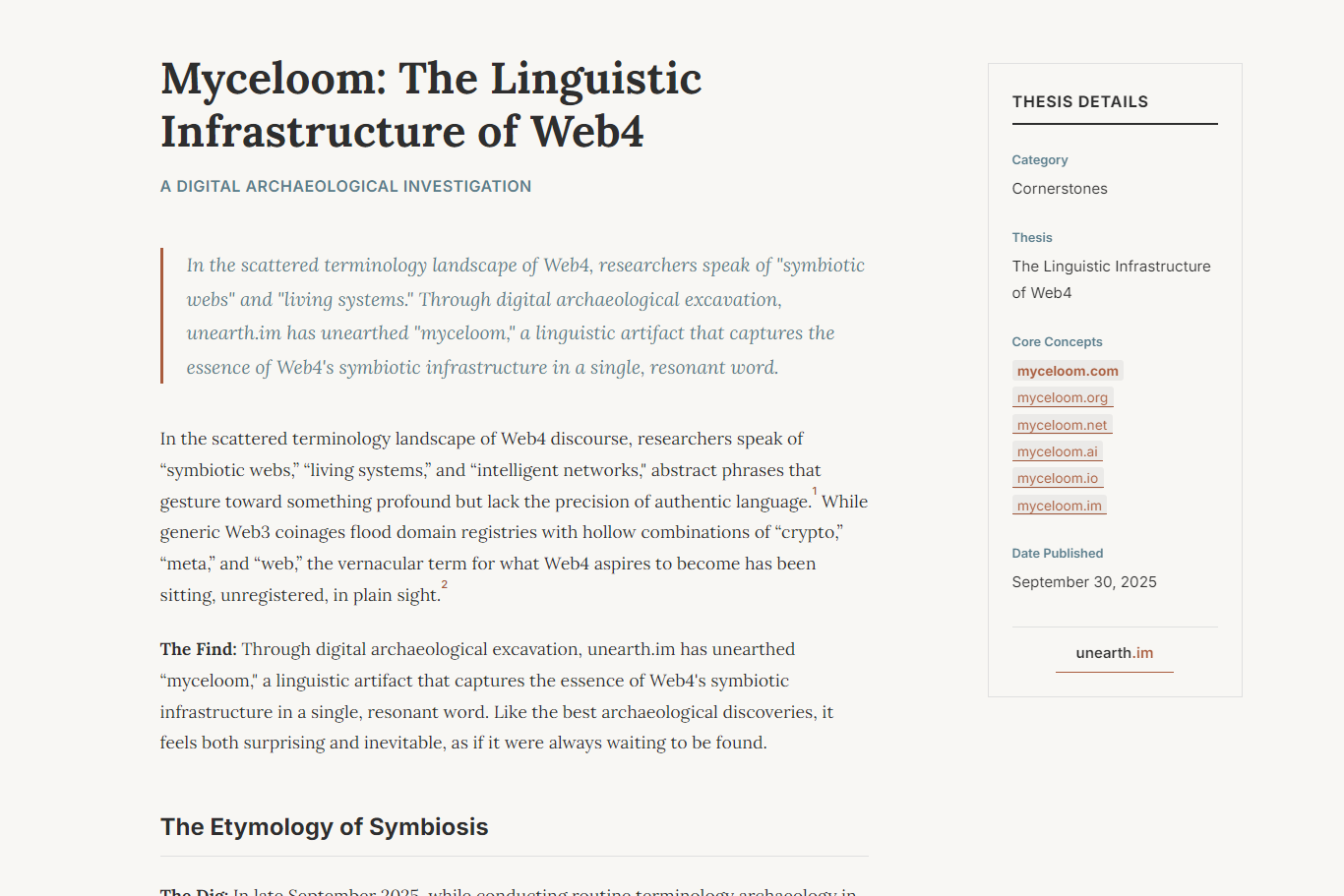
Artifact: myceloom.com
- The Find: A resonant portmanteau blending "mycelium" (the hidden, interconnected fungal networks) and "heirloom" (something precious passed down).
- The Story: This name, forged on our own Anvil, speaks powerfully to interconnected, organic, and resilient systems that carry wisdom across time. It feels simultaneously ancient and futuristic, foundational and emergent, making it the perfect vessel for a community platform, a decentralized technology, or any project built on networked intelligence and enduring value.
Artifact: sentientification.com
- The Find: A carefully crafted neologism suggesting the complex process or gradual emergence of sentience, likely within AI or other complex adaptive systems.
- The Story: This artifact bravely tackles one of the most profound and unsettling questions of the digital age: the nature and threshold of consciousness in artificial intelligence. It's a name purpose-built for researchers, ethicists, philosophers, or platforms dedicated to exploring the boundaries, implications, and future of non-biological sentience.
4.0 Conclusion: The Living Archive, The Future Forge
The "Lexicon of Digital Culture" is not a static project. It is a "Digital Monument" that is alive. It is the "beating heart" of our Archive, a "living" repository that proves our "Digital Archaeologist" ethos is not just a marketing slogan, but a discipline.
We are not just "selling domains." We are the stewards of the stories they contain. We are the curators of the "hand-built web's" collective memory.
A "dictionary" is a book. A "Lexicon" is a landmark. It is a place to "gather," to "explore," and to remember.
But this museum is not meant to be a silent monument to a lost world. It is the living forge. Each artifact preserved here is a lesson, a blueprint, and a piece of raw material for the founders of tomorrow. By understanding the 'narrative gravity' of 'keypal,' a builder can design a more intentional community. By studying the 'dark artifact' of 'enshittification,' a strategist can build a more resilient platform. This Lexicon is our gift to the future—a vocabulary of authenticity for those brave enough to build on their own ground.
We invite you to visit the museum. We invite you to walk through the galleries, read the stories of these artifacts, and remember the "soul" of the web we are all trying to build.
This essay is the thesis. The Monument is the proof.
Citations:
- Barger, J. (1997). Robot Wisdom Weblog. Retrieved from The Internet Archive.
- Doctorow, C. (2023). "Enshittification": The Theory of Platform Decay. Locus Magazine.
- Koenig, J. (2021). The Dictionary of Obscure Sorrows. Simon & Schuster.